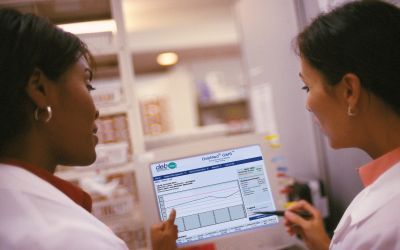Columbia University School of Nursing Launches 'Keep It Clean for Kids' Project
Columbia University School of Nursing has received a $1.2 million grant to research and improve infection prevention practices in pediatric long-term care facilities. The four-year grant from the Agency for Healthcare Research and Quality (AHRQ) will enable researchers to undertake the "Keep It Clean for Kids" (KICK) project, a study assessing hand hygiene at three New York-area facilities that care for children with complex health conditions and disabilities.


The DebMed GMS will be used to assess hand hygiene practices in the "Keep It Clean for Kids" (KICK) project.Â
Columbia University School of Nursing has received a $1.2 million grant to research and improve infection prevention practices in pediatric long-term care facilities. The four-year grant from the Agency for Healthcare Research and Quality (AHRQ) will enable researchers to undertake the "Keep It Clean for Kids" (KICK) project, a study assessing hand hygiene at three New York-area facilities that care for children with complex health conditions and disabilities.
Children in pediatric long-term care facilities account for 40 percent of medical expenditures for children overall, and are at especially high risk of contracting such healthcare-associated infections (HAIs) as MRSA, influenza and hepatitis A. This is the first study of its kind to provide information about the rates and types of infection in these children and test if the KICK intervention can reduce these infections.
The project will be headed by Elaine Larson, RN, PhD, professor of pharmaceutical and therapeutic research and associate dean for research at Columbia University School of Nursing, and Lisa Saiman, MD, MPH, professor of clinical pediatrics at Columbia University Medical Center and hospital epidemiologist at Morgan Stanley Children's Hospital of New York-Presbyterian.
"The goal of this study is to reduce HAIs in pediatric long term care facilities with a tailored intervention that combines innovative technology, active participation of leadership and staff, continuous workflow assessments and feedback," says Larson. "We want to change the patient safety culture so that the benefits of KICK are sustainable and transferable to other pediatric long term care facilities."
The three study sites are: St. Mary's Healthcare System for Children (Bayside, N.Y.), Sunshine Children's Home and Rehab Center (Ossining, N.Y.), and Elizabeth Seton Pediatric Center (New York, N.Y.). Combined, the sites care for approximately 284 children, from newborn to 21 years old, the majority of whom are dependent on staff for almost all their care.
The KICK Project has five key components which involve the active participation of leadership and of staff, assessing work flow, training staff in the World Health Organization's "Five Moments for Hand Hygiene," and the electronic monitoring and feedback of hand hygiene.
Ultimately, the program aims to create a culture change in which all staff 'own' the problem of HAIs in their patients, internalize the need for hand hygiene and other precautions to prevent these infections, create their own solutions, and promulgate these solutions throughout the facilities.Â
A 2011 study* conducted by Columbia in partnership with DebMed, a Charlotte, N.C. hand hygiene technology company, revealed low rates of hand hygiene compliance across various pediatric long-term care facilities. Building on that, the KICK program study will incorporate the DebMed® GMS (group monitoring system) to provide real time data and feedback to staff about their hand hygiene performance.
The DebMed GMS is a real-time electronic hand hygiene monitoring system that measures compliance based on the World Health Organization's "Five Moments for Hand Hygiene." A web-based application then allows 24/7 access to dashboards and reports enabling the three facilities in the KICK study to monitor their hand hygiene compliance and continue to educate their staff on how they can play a role in working towards eliminating HAIs by improving their performance.
"Prevention of HAIs among children in pediatric long-term care facilities has not been well-studied," says Saimon. "Infection prevention efforts involved in this study will extend beyond traditional clinical staff to include teachers, families, and hospital volunteers and, if successful, can be adopted by other clinical settings such as family-centered care, pediatric and adult acute care, and day care."
* Buet A, Cohen B, Marine M, Scully F, Alper P, Simpser E, Saiman L, Larson E. Hand Hygiene Opportunities in Pediatric Extended Care Facilities. Journal of Pediatric Nursing. 2012.
Source: Columbia University School of Nursing; DebMed
Â
The Guardians of Animal Health: Who Are Veterinary Infection Preventionists?
March 21st 2025Veterinary infection control experts Leslie Kollmann, BS, AAS, CVT, CIC, Denise Waiting, LVT, and Leslie Landis, LVT, BS, discuss challenges, zoonotic disease risks, and the importance of education, collaboration, and resource development in animal care facilities.
The Latest on CLABSIs and CAUTIs: Evidence-Based Approaches for Infection Prevention
February 27th 2025Health care–associated infections like CLABSIs and CAUTIs threaten patient safety. Learn evidence-based strategies, new technologies, and prevention protocols to reduce these infections and improve outcomes.
Resilience and Innovation: The Pivotal Contributions of Black Americans to Health Care and Medicine
February 24th 2025During Black History Month, we honor the resilience and contributions of Black medical professionals in health care. Despite barriers, they have led transformative changes, advocating for equitable access and medical excellence. Recognizing their impact ensures a more inclusive health care future for all.
Glove Usage Guideline: From The Joint Commission, CDC, and World Health Organization
February 17th 2025Proper glove use is crucial in health care settings to prevent infections. Guidelines from TJC, CDC, and WHO stress correct selection, usage, and disposal to minimize health care–associated infections (HAIs) and cross-contamination risks. Infection preventionists (IPs) play a key role in educating staff, enforcing compliance, and improving patient safety through standardized glove practices.